HP LaserJet 2410, 2420, 2430 Service Manual
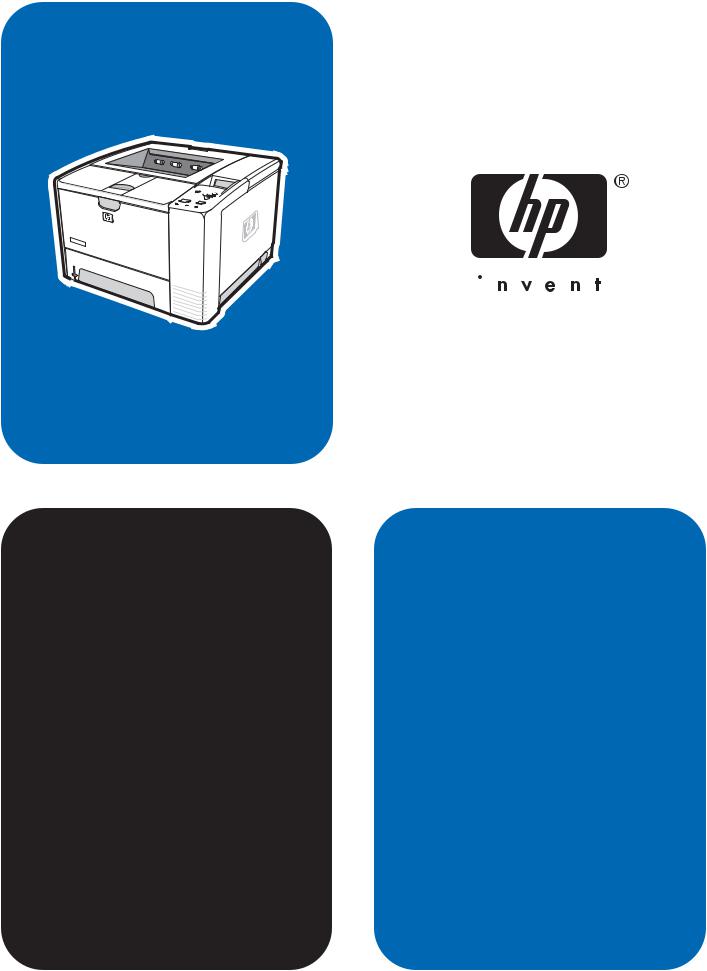
service |
|
|
hp LaserJet 2400 series |
||

HP LaserJet 2400 Series printer
Service Manual

Copyright information
© 2004 Copyright Hewlett-Packard
Development Company, L.P.
Reproduction, adaptation, or translation without prior written permission is prohibited, except as allowed under the copyright laws.
The information contained herein is subject to change without notice.
The only warranties for HP products and services are set forth in the express warranty statements accompanying such products and services. Nothing herein should be construed as constituting an additional warranty. HP shall not be liable for technical or editorial errors or omissions contained herein.
Part number Q5956-90932
Edition 1, 9/2004
Safety information
WARNING!
Potential Shock Hazard
Always follow basic safety precautions when using this product to reduce risk of injury from fire or electric shock.
Read and understand all instructions in the user guide.
Observe all warnings and instructions marked on the product.
Use only a grounded electrical outlet when connecting the printer to a power source. If you do not know whether the outlet is grounded, check with a qualified electrician.
Do not touch the contacts on the end of any of the sockets on the printer. Replace damaged cords immediately.
Unplug this product from wall outlets before cleaning.
Do not install or use this product near water or when you are wet.
Install the product securely on a stable surface.
Install the product in a protected location where no one can step on or trip over the power cord and where the power cord will not be damaged.
If the product does not operate normally, see the online user guide.
Refer all servicing questions to qualified personnel.
Information regarding FCC Class B, Parts 15 and 68 requirements can be found in the user guide.
Trademark credits
Adobe®, Acrobat®, PostScript®, and the Acrobat Logo® are trademarks of Adobe Systems Incorporated.
Java™ is a U.S. trademark of Sun Microsystems, Inc.
Microsoft®, Windows®, and Windows NT® are U.S. registered trademarks of Microsoft Corporation.
UNIX® is a registered trademark of The Open Group.
ENERGY STAR® and the ENERGY STAR logo® are U.S. registered marks of the United States Environmental Protection Agency.
Table of contents
1 Product Information |
|
Chapter contents........................................................................................................................ |
1 |
Printer configurations................................................................................................................. |
2 |
HP LaserJet 2400 Series printer base models.................................................................... |
2 |
Features..................................................................................................................................... |
4 |
Specifications............................................................................................................................. |
8 |
Physical specifications ........................................................................................................ |
8 |
Electrical specifications ...................................................................................................... |
9 |
Acoustic emissions ........................................................................................................... |
10 |
Operating environment ..................................................................................................... |
10 |
Media specifications ................................................................................................................ |
11 |
Supported types and sizes of print media ........................................................................ |
11 |
Paper and print media....................................................................................................... |
12 |
Printing and paper storage environment........................................................................... |
13 |
Envelopes.......................................................................................................................... |
14 |
Envelopes with double side seams .................................................................................. |
14 |
Envelopes with adhesive strips or flaps............................................................................ |
14 |
Envelope margins.............................................................................................................. |
15 |
Envelope storage .............................................................................................................. |
15 |
Labels................................................................................................................................ |
15 |
Transparencies ................................................................................................................. |
15 |
Hewlett-Packard limited warranty statement .......................................................................... |
16 |
Print Cartridge Limited Warranty Statement ........................................................................... |
17 |
HP LaserJet printing supplies ................................................................................................. |
18 |
Declaration of conformity ........................................................................................................ |
19 |
Country-/region-specific safety statements ............................................................................. |
20 |
Laser safety statement ..................................................................................................... |
20 |
Canadian DOC statement ................................................................................................ |
20 |
Japanese VCCI statement ................................................................................................ |
20 |
Korean EMI statement ...................................................................................................... |
20 |
Finnish laser statement .................................................................................................... |
21 |
2 Installation |
|
Chapter contents...................................................................................................................... |
23 |
Operating environment ............................................................................................................ |
24 |
Interface ports ......................................................................................................................... |
24 |
Software................................................................................................................................... |
25 |
Operating systems and printer components .................................................................... |
25 |
Printer drivers ................................................................................................................... |
26 |
Software for Macintosh computers ................................................................................... |
27 |
3 Operation |
|
Chapter contents...................................................................................................................... |
29 |
Control panel............................................................................................................................ |
31 |
ENWW |
iii |
Control-panel layout.......................................................................................................... |
31 |
Control-panel buttons........................................................................................................ |
32 |
Control-panel lights ........................................................................................................... |
33 |
Control-panel language .................................................................................................... |
34 |
Printing control-panel menus ............................................................................................ |
34 |
Selecting which tray is used for printing ................................................................................. |
35 |
Understanding tray order .................................................................................................. |
35 |
Customizing tray 1 operation ............................................................................................ |
36 |
Printing by type and size of media (locking trays) ............................................................ |
37 |
Feeding media from tray 1 manually ................................................................................ |
38 |
Selecting the correct fuser mode ............................................................................................ |
39 |
Using the embedded Web server ........................................................................................... |
40 |
Opening the embedded Web server ................................................................................ |
40 |
Information tab .................................................................................................................. |
41 |
Settings tab ....................................................................................................................... |
41 |
Networking tab .................................................................................................................. |
42 |
Other links ......................................................................................................................... |
42 |
Using HP Web Jetadmin software .......................................................................................... |
43 |
Using the HP Toolbox ............................................................................................................. |
44 |
Supported operating systems ........................................................................................... |
44 |
Supported browsers ......................................................................................................... |
44 |
To view the HP Toolbox ................................................................................................... |
45 |
Status tab .......................................................................................................................... |
45 |
Troubleshooting tab .......................................................................................................... |
46 |
Alerts tab ........................................................................................................................... |
46 |
Documentation tab ........................................................................................................... |
47 |
Device Settings window .................................................................................................... |
47 |
Toolbox links ..................................................................................................................... |
47 |
Other links ......................................................................................................................... |
47 |
Uninstalling the HP Toolbox .................................................................................................... |
48 |
To uninstall the HP Toolbox by using the Windows desktop shortcut ............................. |
48 |
Checking the printer configuration .......................................................................................... |
48 |
Menu map ......................................................................................................................... |
48 |
Configuration page ........................................................................................................... |
49 |
Supplies status page ........................................................................................................ |
51 |
PS or PCL font list ............................................................................................................ |
52 |
Managing the print cartridge ................................................................................................... |
53 |
HP print cartridges ............................................................................................................ |
53 |
Non-HP print cartridges .................................................................................................... |
53 |
Print-cartridge authentication ............................................................................................ |
53 |
Print-cartridge storage ...................................................................................................... |
53 |
Print-cartridge life expectancy .......................................................................................... |
54 |
Checking the supply level ................................................................................................. |
54 |
Cartridge-low and cartridge-out conditions ...................................................................... |
55 |
4 Maintenance |
|
Chapter contents...................................................................................................................... |
57 |
Cleaning the printer ................................................................................................................. |
58 |
Cleaning the outside ......................................................................................................... |
58 |
Cleaning the paper path and print-cartridge areas ........................................................... |
58 |
Cleaning the fuser ............................................................................................................ |
60 |
5 Theory of operation |
|
Chapter contents...................................................................................................................... |
61 |
Introduction............................................................................................................................... |
62 |
iv |
ENWW |
Internal components................................................................................................................. |
63 |
Timing....................................................................................................................................... |
64 |
Engine control system.............................................................................................................. |
66 |
Laser/scanner system.............................................................................................................. |
68 |
Pickup/feed/delivery system.................................................................................................... |
69 |
Image-formation system........................................................................................................... |
71 |
Step 1: Primary charging................................................................................................... |
72 |
Step 2: Laser beam exposure........................................................................................... |
72 |
Step 3: Developing............................................................................................................ |
73 |
Step 4: Transfer................................................................................................................. |
73 |
Step 5: Separation............................................................................................................. |
74 |
Step 6: Fusing.................................................................................................................... |
74 |
Step 7: Drum cleaning....................................................................................................... |
75 |
Print cartridge memory system................................................................................................ |
76 |
6 Removal and replacement |
|
Chapter contents...................................................................................................................... |
77 |
Introduction .............................................................................................................................. |
78 |
Removal and replacement strategy .................................................................................. |
78 |
Electrostatic discharge ..................................................................................................... |
78 |
User-replaceable parts ..................................................................................................... |
78 |
Required tools ................................................................................................................... |
78 |
Before performing service ....................................................................................................... |
79 |
Pre-service procedures .................................................................................................... |
79 |
Parts removal order .......................................................................................................... |
80 |
Covers...................................................................................................................................... |
81 |
Right-side cover................................................................................................................. |
81 |
Back cover......................................................................................................................... |
82 |
I/O cover............................................................................................................................ |
85 |
Left-side cover................................................................................................................... |
86 |
Top, right cover.................................................................................................................. |
88 |
Top cover........................................................................................................................... |
89 |
Front, right cover................................................................................................................ |
90 |
Control panel............................................................................................................................ |
92 |
Formatter.................................................................................................................................. |
94 |
Fuser........................................................................................................................................ |
98 |
Laser/scanner........................................................................................................................ |
103 |
Right-side handle................................................................................................................... |
106 |
ECU........................................................................................................................................ |
108 |
Access plate........................................................................................................................... |
114 |
Power supply.......................................................................................................................... |
115 |
Gear assembly....................................................................................................................... |
120 |
Tray 1 solenoid....................................................................................................................... |
124 |
Tray 2 solenoid....................................................................................................................... |
125 |
E-label reader (memory tag).................................................................................................. |
126 |
Face-down-roller shaft........................................................................................................... |
128 |
Cartridge door........................................................................................................................ |
130 |
Transfer roller......................................................................................................................... |
133 |
Registration assembly............................................................................................................ |
134 |
Tray 1 pickup roller................................................................................................................. |
137 |
Tray 2 pickup roller................................................................................................................. |
138 |
Separation pad....................................................................................................................... |
140 |
7 Troubleshooting |
|
Chapter contents.................................................................................................................... |
141 |
ENWW |
v |
Troubleshooting tree.............................................................................................................. |
143 |
Troubleshooting flowchart ..................................................................................................... |
144 |
1. Does the control-panel display show READY?........................................................... |
144 |
2. Can you print a configuration page? .......................................................................... |
145 |
3. Can you print from a program? .................................................................................. |
146 |
4. Does the job print as expected?.................................................................................. |
147 |
5. Does the printer select the correct trays?................................................................... |
148 |
Troubleshooting tools ............................................................................................................ |
149 |
Information pages ........................................................................................................... |
149 |
Embedded Web server ................................................................................................... |
154 |
Gaining access to the embedded Web server ............................................................... |
154 |
Printer Status and Alerts software .................................................................................. |
156 |
Control-panel menus ............................................................................................................. |
158 |
Using control-panel menus ............................................................................................. |
158 |
Resets submenu ............................................................................................................. |
159 |
Diagnostics menu ........................................................................................................... |
159 |
Service menu (service PIN codes) ................................................................................. |
161 |
Printer resets and power-on modes ...................................................................................... |
163 |
Cold reset ....................................................................................................................... |
163 |
NVRAM initialization ....................................................................................................... |
164 |
Hard-disk initialization ..................................................................................................... |
164 |
Power-on bypass ............................................................................................................ |
165 |
Save + Restore................................................................................................................ |
165 |
Test pages ............................................................................................................................. |
166 |
Engine-test page ............................................................................................................ |
166 |
Formatter test page ........................................................................................................ |
166 |
Interface troubleshooting ...................................................................................................... |
167 |
Communications checks ................................................................................................. |
167 |
EIO troubleshooting ........................................................................................................ |
167 |
Solving general printing problems ......................................................................................... |
169 |
Clearing jams ........................................................................................................................ |
173 |
Avoiding jams ................................................................................................................. |
173 |
Typical jam locations ...................................................................................................... |
174 |
Media handling problems ...................................................................................................... |
181 |
Multiple pages feed ........................................................................................................ |
181 |
Pages are wrinkled or folded .......................................................................................... |
182 |
Pages are skewed .......................................................................................................... |
182 |
Understanding printer messages .......................................................................................... |
183 |
Using the printer online Help system .............................................................................. |
183 |
Resolving persistent messages ...................................................................................... |
183 |
Correcting print-quality problems .......................................................................................... |
201 |
Print-quality checklist ...................................................................................................... |
201 |
Image-defect examples .................................................................................................. |
201 |
Light print (partial page) .................................................................................................. |
203 |
Light print (entire page) .................................................................................................. |
203 |
Specks ............................................................................................................................ |
204 |
Dropouts ......................................................................................................................... |
204 |
Lines ............................................................................................................................... |
205 |
Gray background ............................................................................................................ |
205 |
Toner smear ................................................................................................................... |
206 |
Loose toner ..................................................................................................................... |
206 |
Repeating defects ........................................................................................................... |
207 |
Repeating image ............................................................................................................ |
207 |
Misformed characters ..................................................................................................... |
208 |
Page skew ...................................................................................................................... |
208 |
Curl or wave .................................................................................................................... |
209 |
vi |
ENWW |
Wrinkles or creases ........................................................................................................ |
209 |
Vertical white lines .......................................................................................................... |
210 |
Tire tracks ....................................................................................................................... |
210 |
White spots on black ...................................................................................................... |
211 |
Scattered lines ................................................................................................................ |
211 |
Blurred print .................................................................................................................... |
212 |
Random image repetition ............................................................................................... |
212 |
Troubleshooting common Windows problems ..................................................................... |
213 |
Troubleshooting common Macintosh problems .................................................................... |
214 |
Troubleshooting common PostScript problems .................................................................... |
220 |
General problems ........................................................................................................... |
220 |
Specific errors.................................................................................................................. |
220 |
Printer component locations.................................................................................................. |
222 |
Main assemblies.............................................................................................................. |
222 |
Main parts........................................................................................................................ |
223 |
Sensors and switches...................................................................................................... |
224 |
Motors, fans, and solenoids............................................................................................. |
225 |
PCAs................................................................................................................................ |
226 |
500-Sheet paper feeder................................................................................................... |
227 |
Wiring diagrams..................................................................................................................... |
228 |
General timing diagrams........................................................................................................ |
231 |
8 Parts and diagrams |
|
Chapter contents.................................................................................................................... |
233 |
Ordering parts and supplies .................................................................................................. |
234 |
Parts ............................................................................................................................... |
234 |
Related documentation and software ............................................................................. |
234 |
Supplies .......................................................................................................................... |
234 |
Accessories............................................................................................................................ |
235 |
Covers.................................................................................................................................... |
238 |
Internal components............................................................................................................... |
240 |
Tray 2 pickup assembly......................................................................................................... |
254 |
Alphabetical parts list............................................................................................................. |
256 |
Numerical parts list................................................................................................................. |
262 |
Index |
|
ENWW |
vii |
viii |
ENWW |
List of tables
Table 1-1. |
Feature designations for HP LaserJet 2400 Series printers.............................. |
2 |
Table 1-2. |
Speed ................................................................................................................ |
4 |
Table 1-3. |
Resolution ......................................................................................................... |
4 |
Table 1-4. |
Paper handling .................................................................................................. |
4 |
Table 1-5. |
Memory and processor ..................................................................................... |
5 |
Table 1-6. |
Interface connections and networking .............................................................. |
5 |
Table 1-7. |
Language and fonts .......................................................................................... |
5 |
Table 1-8. |
Print cartridge .................................................................................................... |
6 |
Table 1-9. |
Energy savings .................................................................................................. |
6 |
Table 1-10. |
Economical printing ........................................................................................... |
6 |
Table 1-11. |
Accessibility ....................................................................................................... |
7 |
Table 1-12. |
Product dimensions ........................................................................................... |
8 |
Table 1-13. |
Product dimensions, with all doors and trays fully opened ............................... |
8 |
Table 1-14. |
Power requirements .......................................................................................... |
9 |
Table 1-15. |
Power consumption (average, in watts)1 .......................................................... |
9 |
Table 1-16. |
Sound power and pressure level1 (HP LaserJet 2400 series) ........................ |
10 |
Table 5-1. |
Operation sequences....................................................................................... |
64 |
Table 5-2. |
Power-on sequence......................................................................................... |
64 |
Table 7-1. |
Resets submenu............................................................................................ |
159 |
Table 7-2. |
Diagnostics menu........................................................................................... |
160 |
Table 7-3. |
Common causes of jams................................................................................ |
173 |
Table 7-4. |
Causes for multiple pages feeding................................................................. |
181 |
Table 7-5. |
Causes for wrinkled or folded paper at the paper-path entrance.................. |
182 |
Table 7-6. |
Causes for wrinkled or folded paper at the paper-path exit........................... |
182 |
Table 7-7. |
Causes for skewed pages.............................................................................. |
182 |
Table 7-8. |
Interpreting control-panel messages ............................................................. |
183 |
Table 7-9. |
Problems with Mac OS 9.x ........................................................................... |
214 |
Table 7-10. |
Problems with Mac OS X .............................................................................. |
216 |
Table 8-1. |
Technical support Web sites ......................................................................... |
234 |
Table 8-2. |
Covers............................................................................................................ |
239 |
Table 8-3. |
Internal components (1 of 4).......................................................................... |
241 |
Table 8-4. |
Internal components (2 of 4).......................................................................... |
245 |
Table 8-5. |
Internal components (3 of 4).......................................................................... |
249 |
Table 8-6. |
Internal components (4 of 4).......................................................................... |
251 |
Table 8-7. |
Tray 2 pickup assembly................................................................................. |
255 |
Table 8-8. |
Alphabetical parts list..................................................................................... |
256 |
Table 8-9. |
Numerical parts list......................................................................................... |
262 |
ENWW |
ix |
x |
ENWW |
List of figures
Figure 1-1. |
HP LaserJet 2400 Series printer base model, front/right-side view |
..................2 |
Figure 1-2. |
HP LaserJet 2400 Series printer base model, right-side/rear view................... |
3 |
Figure 3-1. |
Location of the control panel............................................................................ |
31 |
Figure 3-2. |
Control-panel layout......................................................................................... |
31 |
Figure 5-1. |
Block diagram................................................................................................... |
62 |
Figure 5-2. |
Cross-section of printer.................................................................................... |
63 |
Figure 5-3. |
Engine control system...................................................................................... |
66 |
Figure 5-4. |
Engine control system circuit diagram............................................................. |
67 |
Figure 5-5. |
Laser/scanner system...................................................................................... |
68 |
Figure 5-6. |
Pickup/feed/delivery system............................................................................ |
70 |
Figure 5-7. |
Print cartridge diagram..................................................................................... |
71 |
Figure 5-8. |
Image-formation system................................................................................... |
71 |
Figure 5-9. |
Primary charging.............................................................................................. |
72 |
Figure 5-10. |
Developing....................................................................................................... |
73 |
Figure 5-11. |
Transfer............................................................................................................ |
73 |
Figure 5-12. |
Separation........................................................................................................ |
74 |
Figure 5-13. |
Fusing............................................................................................................... |
74 |
Figure 5-14. |
Drum cleaning.................................................................................................. |
75 |
Figure 5-15. |
Print cartridge memory tag .............................................................................. |
76 |
Figure 6-1. |
Parts removal diagram..................................................................................... |
80 |
Figure 6-2. |
Removing the right-side cover......................................................................... |
81 |
Figure 6-3. |
Removing the back cover (1 of 3).................................................................... |
82 |
Figure 6-4. |
Removing the back cover (2 of 3).................................................................... |
83 |
Figure 6-5. |
Removing the back cover (3 of 3).................................................................... |
84 |
Figure 6-6. |
Removing the I/O cover................................................................................... |
85 |
Figure 6-7. |
Removing the left-side cover (1 of 2)............................................................... |
86 |
Figure 6-8. |
Removing the left-side cover (2 of 2)............................................................... |
87 |
Figure 6-9. |
Removing the top, right cover.......................................................................... |
88 |
Figure 6-10. |
Removing the top cover................................................................................... |
89 |
Figure 6-11. |
Removing the front, right cover (1 of 2)........................................................... |
90 |
Figure 6-12. |
Removing the front, right cover (2 of 2)........................................................... |
91 |
Figure 6-13. |
Removing the control panel............................................................................. |
92 |
Figure 6-14. |
Reinstalling the control panel........................................................................... |
93 |
Figure 6-15. |
Removing the formatter (1 of 4)....................................................................... |
94 |
Figure 6-16. |
Removing the formatter (2 of 4)....................................................................... |
95 |
Figure 6-17. |
Removing the formatter (3 of 4)....................................................................... |
96 |
Figure 6-18. |
Removing the formatter (4 of 4)....................................................................... |
97 |
Figure 6-19. |
Removing the fuser (1 of 5)............................................................................. |
98 |
Figure 6-20. |
Removing the fuser (2 of 5)............................................................................. |
99 |
Figure 6-21. |
Removing the fuser (3 of 5)........................................................................... |
100 |
Figure 6-22. |
Removing the fuser (4 of 5)........................................................................... |
101 |
Figure 6-23. |
Removing the fuser (5 of 5)........................................................................... |
102 |
Figure 6-24. |
Removing the laser/scanner (1 of 3).............................................................. |
103 |
Figure 6-25. |
Removing the laser/scanner (2 of 3).............................................................. |
104 |
Figure 6-26. |
Removing the laser/scanner (3 of 3).............................................................. |
105 |
Figure 6-27. |
Removing the right-side handle (1 of 2)......................................................... |
106 |
ENWW |
xi |
Figure 6-28. |
Removing the right-side handle (2 of 2)......................................................... |
107 |
Figure 6-29. |
Removing the ECU (1 of 6)............................................................................ |
108 |
Figure 6-30. |
Removing the ECU (2 of 6)............................................................................ |
109 |
Figure 6-31. |
Removing the ECU (3 of 6)............................................................................ |
110 |
Figure 6-32. |
Removing the ECU (4 of 6)............................................................................ |
111 |
Figure 6-33. |
Removing the ECU (5 of 6)............................................................................ |
112 |
Figure 6-34. |
Removing the ECU (6 of 6)............................................................................ |
113 |
Figure 6-35. |
Removing the access plate............................................................................ |
114 |
Figure 6-36. |
Removing the power supply (1 of 5).............................................................. |
115 |
Figure 6-37. |
Removing the power supply (2 of 5).............................................................. |
116 |
Figure 6-38. |
Removing the power supply (3 of 5).............................................................. |
117 |
Figure 6-39. |
Removing the power supply (4 of 5).............................................................. |
118 |
Figure 6-40. |
Removing the power supply (5 of 5).............................................................. |
119 |
Figure 6-41. |
Removing the gear assembly (1 of 6)............................................................ |
120 |
Figure 6-42. |
Removing the gear assembly (2 of 6)............................................................ |
121 |
Figure 6-43. |
Removing the gear assembly (3 of 6)............................................................ |
122 |
Figure 6-44. |
Reinstalling the gear assembly...................................................................... |
123 |
Figure 6-45. |
Removing the tray 1 solenoid........................................................................ |
124 |
Figure 6-46. |
Removing the tray 2 solenoid........................................................................ |
125 |
Figure 6-47. |
Removing the e-label reader (1 of 2)............................................................. |
126 |
Figure 6-48. |
Removing the e-label reader (2 of 2)............................................................. |
127 |
Figure 6-49. |
Removing the face-down-roller shaft (1 of 2)................................................. |
128 |
Figure 6-50. |
Removing the face-down-roller shaft (2 of 2)................................................. |
129 |
Figure 6-51. |
Removing the cartridge door (1 of 3)............................................................. |
130 |
Figure 6-52. |
Removing the cartridge door (2 of 3)............................................................. |
131 |
Figure 6-53. |
Removing the cartridge door (3 of 3)............................................................. |
132 |
Figure 6-54. |
Removing the transfer roller........................................................................... |
133 |
Figure 6-55. |
Removing the registration assembly (1 of 3)................................................. |
134 |
Figure 6-56. |
Removing the registration assembly (2 of 3)................................................. |
135 |
Figure 6-57. |
Removing the registration assembly (3 of 3)................................................. |
136 |
Figure 6-58. |
Removing the tray 1 pickup roller.................................................................. |
137 |
Figure 6-59. |
Removing the tray 2 pickup roller (1 of 2)...................................................... |
138 |
Figure 6-60. |
Removing the tray 2 pickup roller (2 of 2)...................................................... |
139 |
Figure 6-61. |
Removing the separation pad........................................................................ |
140 |
Figure 7-1. |
Basic troubleshooting..................................................................................... |
143 |
Figure 7-2. |
Sample menu map page................................................................................ |
151 |
Figure 7-3. |
Sample configuration page............................................................................ |
152 |
Figure 7-4. |
Supplies status page...................................................................................... |
153 |
Figure 7-5. |
Jetdirect page................................................................................................. |
168 |
Figure 7-6. |
Main assemblies, HP LaserJet 2400 series................................................... |
222 |
Figure 7-7. |
Main parts, HP LaserJet 2400 series............................................................. |
223 |
Figure 7-8. |
Sensors and switches, HP LaserJet 2400 series.......................................... |
224 |
Figure 7-9. |
Motors, fans, and solenoids, HP LaserJet 2400 series................................. |
225 |
Figure 7-10. |
PCAs, HP LaserJet 2400 series.................................................................... |
226 |
Figure 7-11. |
500-Sheet paper feeder, HP LaserJet 2400 series....................................... |
227 |
Figure 7-12. |
Circuit diagram (1 of 2)................................................................................... |
228 |
Figure 7-13. |
Circuit diagram (2 of 2)................................................................................... |
229 |
Figure 7-14. |
ECU wiring..................................................................................................... |
230 |
Figure 7-15. |
Timing diagram, HP LaserJet 2400 series..................................................... |
231 |
Figure 8-1. |
Covers............................................................................................................ |
238 |
Figure 8-2. |
Internal components (1 of 4).......................................................................... |
240 |
Figure 8-3. |
Internal components (2 of 4).......................................................................... |
244 |
Figure 8-4. |
Internal components (3 of 4).......................................................................... |
248 |
Figure 8-5. |
Internal components (4 of 4).......................................................................... |
250 |
Figure 8-6. |
Tray 2 pickup assembly................................................................................. |
254 |
xii |
ENWW |
1 |
Product Information |
Chapter contents |
|
Chapter contents........................................................................................................................ |
1 |
Printer configurations................................................................................................................. |
2 |
HP LaserJet 2400 Series printer base models.................................................................... |
2 |
Features..................................................................................................................................... |
4 |
Specifications............................................................................................................................. |
8 |
Physical specifications ........................................................................................................ |
8 |
Electrical specifications ...................................................................................................... |
9 |
Acoustic emissions ........................................................................................................... |
10 |
Operating environment ..................................................................................................... |
10 |
Media specifications ................................................................................................................ |
11 |
Supported types and sizes of print media ........................................................................ |
11 |
Paper and print media....................................................................................................... |
12 |
Printing and paper storage environment........................................................................... |
13 |
Envelopes.......................................................................................................................... |
14 |
Envelopes with double side seams .................................................................................. |
14 |
Envelopes with adhesive strips or flaps............................................................................ |
14 |
Envelope margins.............................................................................................................. |
15 |
Envelope storage .............................................................................................................. |
15 |
Labels................................................................................................................................ |
15 |
Transparencies ................................................................................................................. |
15 |
Hewlett-Packard limited warranty statement .......................................................................... |
16 |
Print Cartridge Limited Warranty Statement ........................................................................... |
17 |
HP LaserJet printing supplies ................................................................................................. |
18 |
Declaration of conformity ........................................................................................................ |
19 |
Country-/region-specific safety statements ............................................................................. |
20 |
Laser safety statement ..................................................................................................... |
20 |
Canadian DOC statement ................................................................................................ |
20 |
Japanese VCCI statement ................................................................................................ |
20 |
Korean EMI statement ...................................................................................................... |
20 |
Finnish laser statement .................................................................................................... |
21 |
ENWW |
Chapter contents 1 |
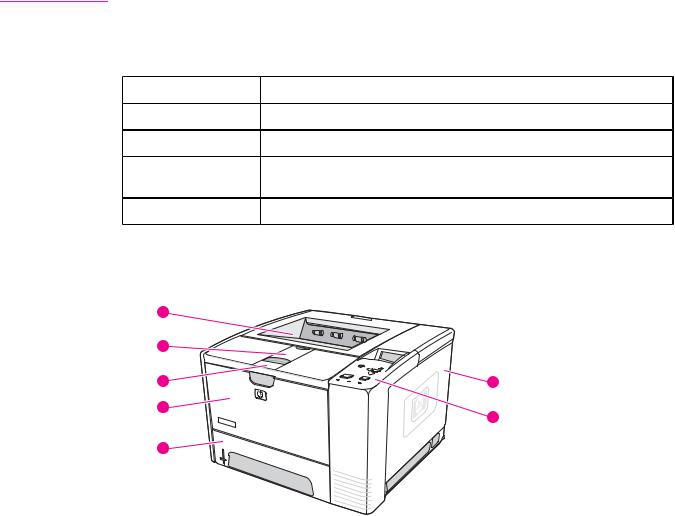
Printer configurations
The HP LaserJet 2400 Series printer is available in several configurations. The letters that follow the printer name indicate the differences between the configurations. Each letter refers to a specific feature. Use the information in this section to determine which features your model has.
NOTE |
Not all models are available in all configurations. |
|
|
Table 1-1. Feature designations for HP LaserJet 2400 Series printers |
|
|
Letter |
Description |
|
no letter |
This is the base model. |
|
d |
A duplexer is included for automatic two-sided printing. |
|
n |
An embedded HP Jetdirect print server is included for connecting to a |
|
|
10/100Base-T network. |
|
t |
An additional input tray is included. |
HP LaserJet 2400 Series printer base models
1 |
|
2 |
|
3 |
7 |
4 |
6 |
|
|
5 |
|
Figure 1-1. HP LaserJet 2400 Series printer base model, front/right-side view
1Top output bin
2Long-media extension
3Cartridge-door latch
4Tray 1
5Tray 2
6Control panel
7Right-side cover
2 Chapter 1 Product Information |
ENWW |

 10
10
8 |
9 |
Figure 1-2. HP LaserJet 2400 Series printer base model, right-side/rear view
8On/off switch
9Interface ports
10Rear output bin
ENWW |
Printer configurations |
3 |

Features
The following tables describe the features of HP LaserJet 2400 Series printers.
Table 1-2. Speed
HP LaserJet 2410 printer |
HP LaserJet 2420 Series |
HP LaserJet 2430 Series |
|
printer |
printer |
Prints on letter-size paper at 25 pages per minute (ppm).
Prints on A4-size paper at 24 ppm.
Prints on letter-size paper at 30 pages per minute (ppm).
Prints on A4-size paper at 28 ppm.
Prints on letter-size paper at 35 pages per minute (ppm).
Prints on A4-size paper at 33 ppm.
Table 1-3. Resolution
HP LaserJet 2410 printer
FastRes 1200 produces 1200dpi print quality for fast, highquality printing of business text and graphics.
ProRes 1200 produces 1200dpi printing for the best quality in line art and graphic images.
HP LaserJet print cartridges produce crisp, sharp output.
HP LaserJet 2420 Series printer
FastRes 1200 produces 1200dpi print quality for fast, highquality printing of business text and graphics.
ProRes 1200 produces 1200dpi printing for the best quality in line art and graphic images.
HP LaserJet print cartridges produce crisp, sharp output.
HP LaserJet 2430 Series printer
FastRes 1200 produces 1200dpi print quality for fast, highquality printing of business text and graphics.
ProRes 1200 produces 1200dpi printing for the best quality in line art and graphic images.
HP LaserJet print cartridges produce crisp, sharp output.
Table 1-4. Paper handling
HP LaserJet 2410 printer
Includes a 100-sheet manualfeed input tray and a 250-sheet input tray.
Compatible with an optional 500-sheet paper feeder.
Manual duplexing is available.
HP LaserJet 2420 Series printer
Includes a 100-sheet manualfeed input tray and a 250-sheet input tray.
Compatible with an optional 500-sheet paper feeder.
The HP LaserJet 2420d and 2420dn printers include a duplex-printing accessory (duplexer) for automatic twosided printing.
HP LaserJet 2430 Series printer
Includes a 100-sheet manualfeed input tray, a 250-sheet input tray, and a 500-sheet input tray.
The HP LaserJet 2430dtn printers include a duplexprinting accessory (duplexer) for automatic two-sided printing.
4 Chapter 1 Product Information |
ENWW |
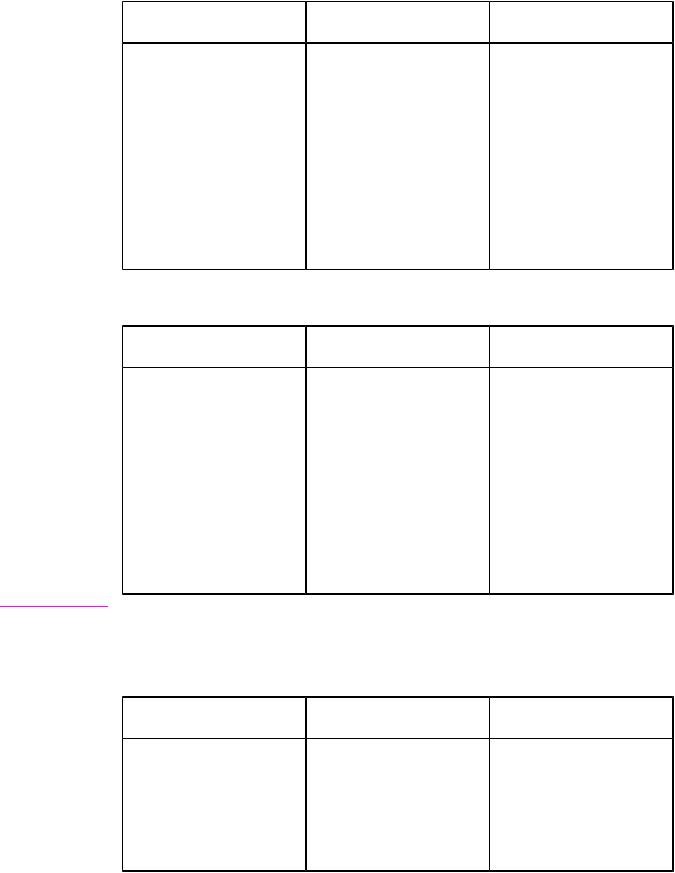
Table 1-5. Memory and processor
HP LaserJet 2410 printer
Includes 32 MB of RAM.
Expandable up to 288 MB maximum memory.
400-MHz processor speed.
HP LaserJet 2420 Series printer
The HP LaserJet 2420 printer includes 32 MB of RAM, expandable to 288 MB maximum memory.
The HP LaserJet 2420d printer includes 48 MB RAM, expandable to 304 MB maximum memory.
The HP LaserJet 2420n and 2420dn printers include 64 MB RAM, expandable to 320 MB maximum memory.
400-MHz processor speed.
HP LaserJet 2430 Series printer
The HP LaserJet 2430t printer includes 48 MB of RAM, expandable to 304 MB maximum memory.
The HP LaserJet 2430tn and 2430dtn printers include 64 MB RAM, expandable to 320 MB maximum memory.
400-MHz processor speed.
Table 1-6. Interface connections and networking
HP LaserJet 2410 printer
Includes a bidirectional, extended capabilities (ECP) type-B (IEEE 1284-compliant) parallel connection.
Includes a USB 2.0 connection (full and high speed).
Includes one PCI-based enhanced input/output (EIO) expansion slot.
HP LaserJet 2420 Series printer
Includes a bidirectional, ECP type-B (IEEE 1284-compliant) parallel connection.
Includes a USB 2.0 connection (full and high speed).
Includes one PCI-based enhanced input/output (EIO) expansion slot.
The HP LaserJet 2420n and 2420dn printers include an embedded HP Jetdirect print server for connecting to a 10/100Base-TX network.
HP LaserJet 2430 Series printer
Includes a bidirectional, ECP type-B (IEEE 1284-compliant) parallel connection.
Includes a USB 2.0 connection (full and high speed).
Includes one PCI-based enhanced input/output (EIO) expansion slot.
The HP LaserJet 2430tn and 2430dtn printers include an embedded HP Jetdirect print server for connecting to a 10/100Base-TX network.
NOTE |
48 MB RAM is required for network connectivity for the HP LaserJet 2410 and HP LaserJet |
|
2420 printer base models. |
|
Table 1-7. Language and fonts |
HP LaserJet 2410 printer
HP PCL6, PCL 5e, and
HP PostScript® (PS) 3 emulation
80 fonts for Microsoft® Windows®
Additional fonts can be added by installing a CompactFlash font card.
HP LaserJet 2420 Series printer
HP PCL6, PCL 5e, and
HP PostScript® (PS) 3 emulation
80 fonts for Microsoft® Windows®
Additional fonts can be added by installing a CompactFlash font card.
HP LaserJet 2430 Series printer
HP PCL6, PCL 5e, and
HP PostScript® (PS) 3 emulation
80 fonts for Microsoft® Windows®
Additional fonts can be added by installing a CompactFlash font card.
ENWW |
Features 5 |
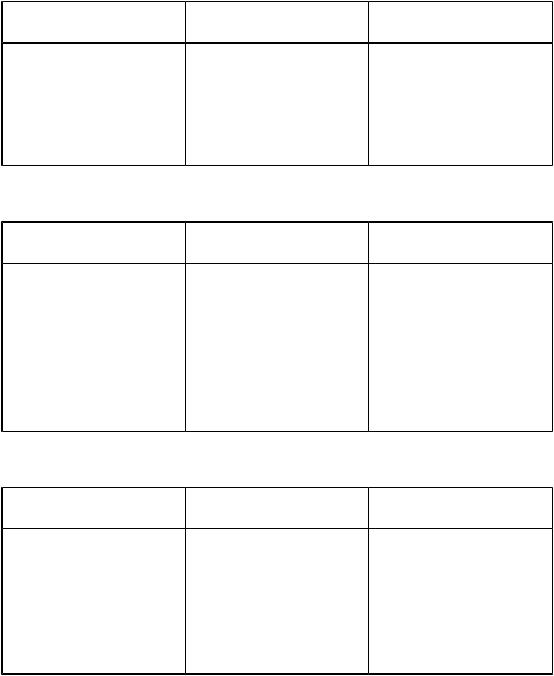
Table 1-8. Print cartridge
HP LaserJet 2410 printer
The standard print cartridge prints up to 6,000 pages. "Extended life" print cartridges print up to 12,000 pages.
The HP smart-printing-supplies program automatically alerts when toner is low.
HP LaserJet 2420 Series printer
The standard print cartridge prints up to 6,000 pages. "Extended life" print cartridges print up to 12,000 pages.
The HP smart-printing-supplies program automatically alerts when toner is low.
HP LaserJet 2430 Series printer
The standard print cartridge prints up to 6,000 pages. "Extended life" print cartridges print up to 12,000 pages.
The HP smart-printing-supplies- program automatically alerts when toner is low.
Table 1-9. Energy savings
HP LaserJet 2410 printer
The printer automatically conserves electricity by reducing power consumption when it is not printing.
As an ENERGY STAR® partner, Hewlett-Packard Company has determined that this product meets ENERGY STAR® guidelines for energy efficiency.
HP LaserJet 2420 Series printer
The printer automatically conserves electricity by reducing power consumption when it is not printing.
As an ENERGY STAR® partner, Hewlett-Packard Company has determined that this product meets ENERGY STAR® guidelines for energy efficiency.
HP LaserJet 2430 Series printer
The printer automatically conserves electricity by reducing power consumption when it is not printing.
As an ENERGY STAR® partner, Hewlett-Packard Company has determined that this product meets ENERGY STAR® guidelines for energy efficiency.
Table 1-10. Economical printing
HP LaserJet 2410 printer
N-up printing (multiple pages on one sheet) saves paper.
Duplex printing (manual duplexing only) saves paper.
Printing in EconoMode saves toner.
HP LaserJet 2420 Series printer
N-up printing (multiple pages on one sheet) saves paper.
Duplex printing (manual duplexing, or automatic duplexing for models that include a duplexer) saves paper.
Printing in EconoMode saves toner.
HP LaserJet 2430 Series printer
N-up printing (multiple pages on one sheet) saves paper.
Duplex printing (manual duplexing, or automatic duplexing for models that include a duplexer) saves paper.
Printing in EconoMode saves toner.
6 Chapter 1 Product Information |
ENWW |
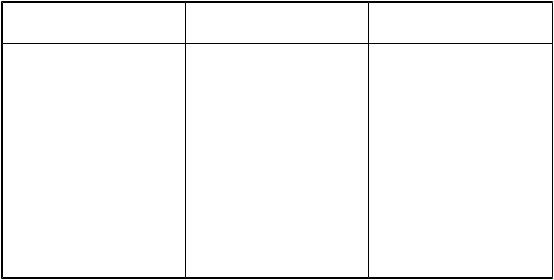
Table 1-11. Accessibility
HP LaserJet 2410 printer
The online user guide is compatible with text screenreaders.
The print cartridge can be inserted and removed by using one hand.
All doors and covers can be opened by using one hand.
The 250-sheet input tray is easy to open and close.
All media-width guides can be adjusted by using one hand.
HP LaserJet 2420 Series printer
The online user guide is compatible with text screenreaders.
The print cartridge can be inserted and removed by using one hand.
All doors and covers can be opened by using one hand.
The 250-sheet input tray is easy to open and close.
All media-width guides can be adjusted by using one hand.
HP LaserJet 2430 Series printer
The online user guide is compatible with text screenreaders.
The print cartridge can be inserted and removed by using one hand.
All doors and covers can be opened by using one hand.
The 250-sheet and 500-sheet input trays are easy to open and close.
All media-width guides can be adjusted by using one hand.
ENWW |
Features 7 |
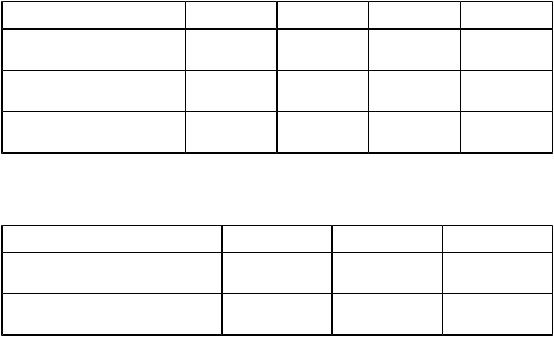
Specifications
Physical specifications
Table 1-12. Product dimensions
Product |
Height |
Depth |
Width |
Weight1 |
HP LaserJet 2410, 2420, |
260 mm |
400 mm |
425 mm |
15.2 kg |
2420d, 2420n, and 2420dn |
(10.2 inches) |
(15.7 inches) |
(16.7 inches) |
(33.5 lb) |
HP LaserJet 2430t, 2430tn, |
400 mm |
400 mm |
425 mm |
20.9 kg (46 lb) |
and 2430dtn |
(15.7 inches) |
(15.7 inches) |
(16.7 inches) |
|
optional 500-sheet feeder |
140 mm |
400 mm |
425 mm |
5.7 kg (12.5 lb) |
|
(5.5 inches) |
(15.7 inches) |
(15.7 inches) |
|
1Without print cartridge
Table 1-13. Product dimensions, with all doors and trays fully opened
Printer model |
Height |
Depth |
Width |
HP LaserJet 2410, 2420, 2420d, |
260 mm |
730 mm |
675 mm |
2420n, and 2420dn |
(10.2 inches) |
(28.7 inches) |
(26.6 inches) |
HP LaserJet 2430t, 2430tn, and |
400 mm |
730 mm |
675 mm |
2430dtn |
(15.7 inches) |
(28.7 inches) |
(26.6 inches) |
8 Chapter 1 Product Information |
ENWW |

Electrical specifications
WARNING! Power requirements are based on the country/region where the printer is sold. Do not convert operating voltages. This can damage the printer and void the product warranty.
Table 1-14. Power requirements
Specification |
110-volt models |
230-volt models |
Power requirements |
110 to 127 volts (± 10%) |
220 to 240 volts (± 10%) |
|
50/60 Hz (± 2 Hz) |
50/60 Hz (± 2 Hz) |
Rated short-term current |
10.0 Amps |
5.0 Amps |
Table 1-15. Power consumption (average, in watts)1
Product model |
Printing2 |
Ready |
Sleep |
Off |
HP LaserJet 2410 |
625 W3 |
11 W |
8.5 W |
0.4 W |
HP LaserJet 2420 |
625 W3 |
11 W |
8.5 W |
0.4 W |
HP LaserJet 2420d |
625 W3 |
11 W |
8.5 W |
0.4 W |
HP LaserJet 2420n |
625 W3 |
11 W |
8.5 W |
0.4 W |
HP LaserJet 2420dn |
625 W3 |
11 W |
8.5 W |
0.4 W |
HP LaserJet 2430t |
625 W3 |
11 W |
8.5 W |
0.4 W |
HP LaserJet 2430tn |
625 W3 |
11 W |
8.5 W |
0.4 W |
HP LaserJet 2430dtn |
625 W3 |
11 W |
8.5 W |
0.4 W |
1Values subject to change. See www.hp.com/support/lj2410, www.hp.com/support/lj2420, or www.hp.com/support/lj2430 for current information.
2Power numbers are the highest values measured using all standard voltages.
3HP LaserJet 2410 speed is 25 ppm on letter size and 24 ppm on A4 size. HP LaserJet 2420 speed is 30 ppm on letter size and 28 ppm on A4 size. HP LaserJet 2430 speed is 35 ppm on letter size and 33 ppm on A4 size.
Default time from Ready mode to Sleep = 30 minutes. The recovery time from Sleep to start of printing = less than 8.5 seconds.
Heat dissipation in Ready mode = 37.5 BTU/hour (HP LaserJet 2410), 37.5 BTU/hour (HP LaserJet 2420), and 37.5 BTU/hour (HP LaserJet 2430).
ENWW |
Specifications 9 |
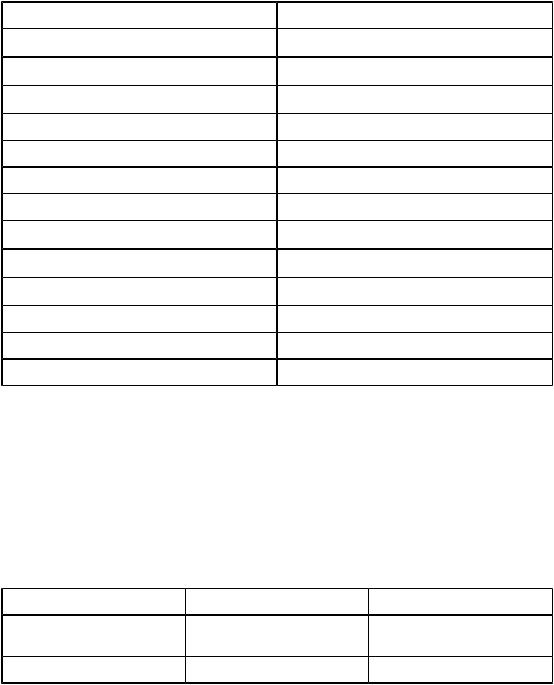
Acoustic emissions
Table 1-16. Sound power and pressure level1 (HP LaserJet 2400 series)
Sound power level |
Declared per ISO 9296 |
Printing2 (HP LaserJet 2410) |
LWAd= 6.6 Bels (A) [66 dB(A)] |
Printing2 (HP LaserJet 2420) |
LWAd= 6.7 Bels (A) [67 dB(A)] |
Printing2 (HP LaserJet 2430) |
LWAd= 6.8 Bels (A) [68 dB(A)] |
Ready (HP LaserJet 2410) |
Essentially Inaudible |
Ready (HP LaserJet 2420) |
Essentially Inaudible |
Ready (HP LaserJet 2430) |
Essentially Inaudible |
Sound pressure level |
Declared per ISO 9296 |
Printing2 (HP LaserJet 2410) |
LpAm=52 dB (A) |
Printing2 (HP LaserJet 2420) |
LpAm=53 dB (A) |
Printing2 (HP LaserJet 2430) |
LpAm=53 dB (A) |
Ready (HP LaserJet 2410) |
Essentially Inaudible |
Ready (HP LaserJet 2420) |
Essentially Inaudible |
Ready (HP LaserJet 2430) |
Essentially Inaudible |
1Values subject to change. See www.hp.com/support/lj2410, www.hp.com/support/lj2420, or www.hp.com/support/lj2430 for current information.
2HP LaserJet 2410 speed is 25 ppm on A4 size. HP LaserJet 2420 speed is 29 ppm on A4 size. HP LaserJet 2430 speed is 34 ppm on A4 size.
3Configuration tested (HP LaserJet 2410): Base printer, simplex printing with A4 paper size. 4Configuration tested (HP LaserJet 2420): Base printer, simplex printing with A4 paper size. 5Configuration tested (HP LaserJet 2430): Base printer, simplex printing with A4 paper size.
Operating environment
Environmental condition |
Printing |
Storage/standby |
Temperature (printer and print |
15° to 32.5°C (59° to 89°F) |
-20° to 40°C (-4° to 104°F) |
cartridge) |
|
|
Relative humidity |
10% to 80% |
10% to 90% |
10 Chapter 1 Product Information |
ENWW |

Media specifications
NOTE
CAUTION
The printer accepts a variety of media, such as cut-sheet paper, including up to 100% recycled fiber content paper; envelopes; labels; transparencies; and custom-size paper. Properties such as weight, composition, grain, and moisture content are important factors that affect printer performance and output quality. Media that does not meet the guidelines that are outlined in this manual can cause the following problems:
●Poor print quality
●Increased jams
●Premature wear on the printer, requiring repair
Some media might meet all of media specifications and still not produce satisfactory results. Improper handling, unacceptable temperature and humidity levels, and other variables over which Hewlett-Packard has no control can affect print quality. Before purchasing large quantities of media, make sure that it meets the requirements that are specified in the user guide and in theHP LaserJet Printer Family Print Media Guide, which is available for download at http://www.hp.com/support/ljpaperguide. Always test paper before buying large quantities.
Using media that does not meet HP specifications can cause problems for the printer, requiring repair. This repair is not covered by the HP warranty or service agreements.
NOTE
Supported types and sizes of print media
Column Tray 1 |
Dimensions1 |
Weight |
Capacity2 |
heading |
|
|
|
Minimum size |
76 x 127 mm |
60 to 199 g/m2 (16 to 53 lb) |
100 sheets of |
(custom) |
(3 x 5 inches) |
|
75 g/m2 (20 lb) |
Maximum size |
216 x 356 mm |
|
paper |
|
|
||
(custom) |
(8.5 x 14 inches) |
|
|
Transparency |
(Same as |
Thickness: 0.10 to 0.14 mm |
75 typical |
|
preceding |
(0.0039 to 0.0055 inch) |
|
Labels3 |
minimum and |
Thickness: 0.10 to 0.14 mm |
50 typical |
maximum paper |
|||
|
sizes.) |
(0.0039 to 0.005 inch) |
|
Envelopes |
|
Up to 90 g/m2 (16 to 24 lb) |
Up to 10 |
1The printer supports a wide range of sizes. See the printer software for supported sizes. To print on custom-size paper, see the user guide.
2Capacity can vary depending on media weight and thickness, as well as on environmental conditions.
3Smoothness: 100 to 250 (Sheffield)
You might experience some jams when using any media that is less than 178 mm (7 inches) long. These jams might be caused by media that has been affected by environmental conditions. For optimum performance, make sure that you are storing and handling the media correctly (see Printing and paper storage environment).
ENWW |
Media specifications 11 |

Tray 2 (250-sheet tray) |
Dimensions1 |
Weight |
Capacity2 |
and tray 3 (500-sheet |
|
|
|
tray) |
|
|
|
Letter |
216 x 279 mm |
60 to 120 g/m2 |
250 sheets of 75 g/m2 |
|
(8.5 x 11 inches) |
(16 to 32 lb) |
(20 lb) media |
|
|
|
|
A4 |
210 x 297 mm |
|
|
|
(8.3 x 11.7 inches) |
|
|
Executive |
191 x 267 mm |
|
|
|
(7.3 x 10.5 inches) |
|
|
Legal |
216 x 356 mm |
|
|
|
(8.5 x 14 inches) |
|
|
B5 (JIS) |
182 x 257 mm |
|
|
|
(7.2 x 10 inches) |
|
|
A5 |
148 x 210 mm |
|
|
|
(5.8 x 8.3 inches) |
|
|
8.5 x 13 inches |
216 x 330 mm |
|
|
|
(8.5 x 13 inches) |
|
|
1The printer supports a wide range of sizes. See the printer software for supported sizes. To print on custom-size paper, see the user guide.
2Capacity can vary depending on media weight and thickness, as well as on environmental conditions.
Built-in duplexer1 |
Dimensions2 |
Weight |
Letter |
216 x 279 mm (8.5 x 11 inches) |
60 to 105 g/m2 (16 to 28 lb Bond) |
A4 |
210 x 297 mm (8.3 x 11.7 inches) |
|
Legal |
216 x 356 mm (8.5 x 14 inches) |
|
8.5 x 13 inches |
216 x 330 mm (8.5 x 13 inches) |
|
|
1The built-in duplexer is included only with the HP LaserJet 2420d, 2420dn, and 2430dtn |
|
printers. |
|
2The printer supports a wide range of sizes. See the printer software for supported sizes. To |
|
print on custom-size paper, see the user guide. |
|
Prepunched media is not supported for automatic duplexing. |
NOTE |
|
|
For more information about using print media, see the user guide. |
Paper and print media
For complete media specifications for all HP LaserJet printers, see the HP LaserJet Printer Family Print Media Guide (available at http://www.hp.com/support/ljpaperguide).
12 Chapter 1 Product Information |
ENWW |

Category |
Specifications |
Acid content |
5.5 pH to 8.0 pH |
Caliper |
0.094 to 0.18 mm (3.0 to 7.0 mils) |
Curl in ream |
Flat within 5 mm (0.02 inch) |
Cut edge conditions |
Cut with sharp blades with no visible fray |
Fusing compatibility |
Must not scorch, melt, offset, or release |
|
hazardous emissions when heated to 200°C |
|
(392°F) for 0.1 second |
Grain |
Long grain |
Moisture content |
4% to 6% by weight |
Smoothness |
100 to 250 Sheffield |
Printing and paper storage environment
Ideally, the printing and paper storage environment should be at or near room temperature, and not too dry or too humid. Remember paper is hygroscopic; it absorbs and loses moisture rapidly.
Heat works with humidity to damage paper. Heat causes the moisture in paper to evaporate, while cold causes it to condense on the sheets. Heating systems and air conditioners remove most of the humidity from a room. As paper is opened and used, it loses moisture, causing streaks and smudging. Humid weather or water coolers can cause the humidity to increase in a room. As paper is opened and used it absorbs any excess moisture, causing light print and dropouts. Also, as paper loses and gains moisture it can distort. This can cause jams.
As a result, paper storage and handling are as important as the paper-making process itself. Paper storage environmental conditions directly affect the feed operation.
Care should be taken not to purchase more paper than can be easily used in a short time (about 3 months). Paper stored for long periods might experience heat and moisture extremes, which can cause damage. Planning is important to prevent damage to a large supply of media.
Unopened paper in sealed reams can remain stable for several months before use. Opened packages of media have more potential for environmental damage, especially if they are not wrapped with a moisture-proof barrier.
The paper storage environment should be properly maintained to ensure optimum printer performance. The required condition is 20° to 24°C (68° to 75°F), with a relative humidity of 45% to 55%. The following guidelines should be helpful when evaluating the paper's storage environment:
●Paper should be stored at or near room temperature.
●The air should not be too dry or too humid (due to the hygroscopic properties of paper).
●The best way to store an opened ream of media is to rewrap it tightly in its moistureproof wrapping. If the printer environment is subject to extremes, unwrap only the amount of media to be used during the day's operation to prevent unwanted moisture changes.
ENWW |
Media specifications 13 |
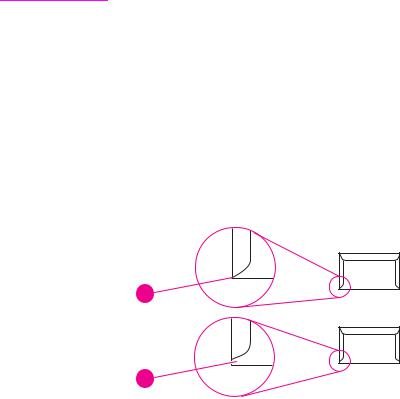
Envelopes
Envelope construction is critical. Envelope fold lines can vary considerably, not only between manufacturers, but also within a box from the same manufacturer. Successful printing on envelopes depends upon the quality of the envelopes. When selecting envelopes, consider the following components:
●Weight: The weight of the envelope paper should not exceed 105 g/m2 (28 lb) or jamming might occur.
●Construction: Prior to printing, envelopes should lie flat with less than 6 mm (0.25 inch) curl, and should not contain air.
●Condition:Envelopes should not be wrinkled, nicked, or otherwise damaged.
●Temperature: You should use envelopes that are compatible with the heat and pressure of the printer.
●Size: You should use only envelopes within the following size ranges.
●Minimum: 76 x 127 mm (3 x 5 inches)
●Maximum: 216 x 356 mm (8.5 x 14 inches)
NOTE |
Use only tray 1 to print envelopes. You might experience some jams when using any media |
|
with a length less than 178 mm (7 inches). This might be caused by paper that has been |
|
affected by environmental conditions. For optimum performance, make sure you are storing |
|
and handling the paper correctly (see Printing and paper storage environment). Choose |
|
envelopes in the printer driver (see Printer drivers). |
Envelopes with double side seams
Double side-seam construction has vertical seams at both ends of the envelope rather than diagonal seams. This style might be more likely to wrinkle. Be sure the seam extends all the way to the corner of the envelope as illustrated below.
1 
2
1Acceptable envelope construction
2Unacceptable envelope construction
Envelopes with adhesive strips or flaps
Envelopes with a peel-off adhesive strip or with more than one flap that folds over to seal must use adhesives compatible with the heat and pressure in the printer. The extra flaps and strips might cause wrinkling, creasing, or even jams and might even damage the fuser.
14 Chapter 1 Product Information |
ENWW |
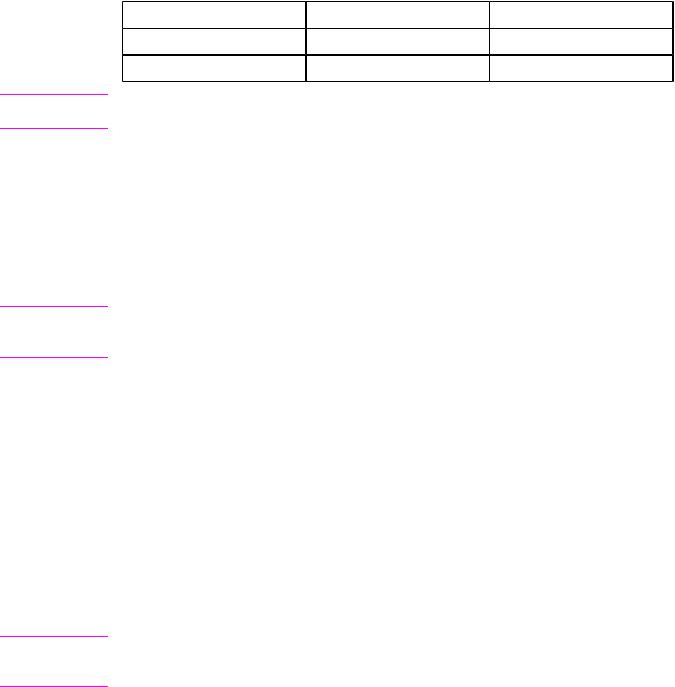
NOTE
CAUTION
CAUTION
Envelope margins
The following gives typical address margins for a commercial #10 or DL envelope.
Type of address |
Top margin |
Left margin |
Return address |
15 mm (0.6 inch) |
15 mm (0.6 inch) |
Delivery address |
51 mm (2 inches) |
89 mm (3.5 inches) |
For the best print quality, position margins no closer than 15 mm (0.6 inch) from the edges of the envelope. Avoid printing over the area where the envelope's seams meet.
Envelope storage
Proper storage of envelopes helps contribute to print quality. Envelopes should be stored flat. If air is trapped in an envelope, creating an air bubble, then the envelope might wrinkle during printing.
Labels
To avoid damaging the printer, use only labels recommended for laser printers. To prevent serious jams, always use tray 1 to print labels and always use the rear output bin. Never print on the same sheet of labels more than once or print on a partial sheet of labels.
When selecting labels, consider the quality of each component:
●Adhesives: The adhesive material should be stable at 200°C (392°F), the printer's fusing temperature.
●Arrangement: Only use labels with no exposed backing between them. Labels can peel off sheets with spaces between the labels, causing serious jams.
●Curl: Prior to printing, labels must lie flat with no more than 13 mm (0.5 inch) of curl in any direction.
●Condition: Do not use labels with wrinkles, bubbles, or other indications of separation.
Transparencies
Transparencies used in the printer must be able to withstand 200°C (392°F), the printer's fusing temperature.
To avoid damaging the printer, use only transparencies recommended for use in
HP LaserJet printers, such as HP-brand transparencies. (For ordering information, see Ordering parts and supplies.)
ENWW |
Media specifications 15 |
Hewlett-Packard limited warranty statement
HP PRODUCT |
DURATION OF LIMITED WARRANTY |
HP LaserJet 2410, 2420, and 2430 series |
1 year, Return to Authorized Service Center |
HP warrants to you, the end-user customer, that HP hardware and accessories will be free from defects in materials and workmanship after the date of purchase, for the period specified above. If HP receives notice of such defects during the warranty period, HP will, at its option, either repair or replace products which prove to be defective. Replacement products may be either new or equivalent in performance to new.
HP warrants to you that HP software will not fail to execute its programming instructions after the date of purchase, for the period specified above, due to defects in material and workmanship when properly installed and used. If HP receives notice of such defects during the warranty period, HP will replace software which does not execute its programming instructions due to such defects.
HP does not warrant that the operation of HP products will be uninterrupted or error free. If HP is unable, within a reasonable time, to repair or replace any product to a condition as warranted, you will be entitled to a refund of the purchase price upon prompt return of the product.
HP products may contain remanufactured parts equivalent to new in performance or may have been subject to incidental use.
Warranty does not apply to defects resulting from (a) improper or inadequate maintenance or calibration, (b) software, interfacing, parts or supplies not supplied by HP, (c) unauthorized modification or misuse, (d) operation outside of the published environmental specifications for the product, or (e) improper site preparation or maintenance.
TO THE EXTENT ALLOWED BY LOCAL LAW, THE ABOVE WARRANTIES ARE EXCLUSIVE AND NO OTHER WARRANTY OR CONDITION, WHETHER WRITTEN OR ORAL, IS EXPRESSED OR IMPLIED AND
HP SPECIFICALLY DISCLAIMS ANY IMPLIED WARRANTIES OR CONDITIONS OF MERCHANTABILITY, SATISFACTORY QUALITY, AND FITNESS FOR A PARTICULAR PURPOSE. Some countries/regions, states or provinces do not allow limitations on the duration of an implied warranty, so the above limitation or exclusion might not apply to you. This warranty gives you specific legal rights and you might also have other rights that vary from country/region to country/region, state to state, or province to province. HP's limited warranty is valid in any country/region or locality where HP has a support presence for this product and where HP has marketed this product. The level of warranty service you receive may vary according to local standards. HP will not alter form, fit or function of the product to make it operate in a country/region for which it was never intended to function for legal or regulatory reasons.
TO THE EXTENT ALLOWED BY LOCAL LAW, THE REMEDIES IN THIS WARRANTY STATEMENT ARE YOUR SOLE AND EXCLUSIVE REMEDIES. EXCEPT AS INDICATED ABOVE, IN NO EVENT WILL HP OR ITS SUPPLIERS BE LIABLE FOR LOSS OF DATA OR FOR DIRECT, SPECIAL, INCIDENTAL, CONSEQUENTIAL (INCLUDING LOST PROFIT OR DATA), OR OTHER DAMAGE, WHETHER BASED IN CONTRACT, TORT, OR OTHERWISE. Some countries/regions, states or provinces do not allow the exclusion or limitation of incidental or consequential damages, so the above limitation or exclusion may not apply to you.
THE WARRANTY TERMS CONTAINED IN THIS STATEMENT, EXCEPT TO THE EXTENT LAWFULLY PERMITTED, DO NOT EXCLUDE, RESTRICT OR MODIFY AND ARE IN ADDITION TO THE MANDATORY STATUTORY RIGHTS APPLICABLE TO THE SALE OF THIS PRODUCT TO YOU.
16 Chapter 1 Product Information |
ENWW |
